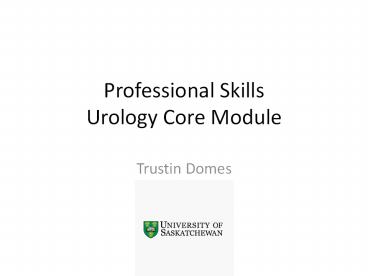Professional Skills Urology Core Module - PowerPoint PPT Presentation
1 / 13
Title:
Professional Skills Urology Core Module
Description:
Outline Brief Anatomy of Scrotum and Prostate ... S1-S10 Prostate Anatomy Peripheral Zone = 85% of prostate cancer ... PowerPoint Presentation Author: – PowerPoint PPT presentation
Number of Views:149
Avg rating:3.0/5.0
Title: Professional Skills Urology Core Module
1
Professional SkillsUrology Core Module
- Trustin Domes
2
Outline
- Brief Anatomy of Scrotum and Prostate
- Physical Examination CVA, Scrotum and DRE
- Case Scenarios
- LUTS
- Hematuria
- Upper and lower urinary tract obstruction
- Scrotal Masses/Pain
3
Anatomy of Scrotal Contents
- Vessels
- Testicle has 3 arterial blood supplies
- Testicular artery
- Cremasteric artery
- Deferential artery
- Pampiniform venous plexus
- Lymphatics
- Nerves
- Cremasteric muscle/fascia
- Vas deferens
4
Anatomy of Scrotal Contents
- Vas is the most posterior component of spermatic
cord - Tunica vaginalis surrounds the anterior 2/3rd of
the testicle and creates a potential space for
hydroceles and hematoceles
5
Clinical Anatomy of the Prostate
Verma S , Rajesh A AJR 2011196S1-S10
6
Prostate Anatomy
- Peripheral Zone 85 of prostate cancer
originate in this zone, therefore are detected on
DRE - Transition Zone site of benign prostatic
hyperplasia
7
CVA and Ballottement
- If CVA tenderness think
- Renal colic
- Pyelonephritis
- Significant renal trauma
- Renal vascular occlusion
If you can ballot the kidney think - Large renal
mass - Polycystic kidney disease - Severely
hydronephrotic kidney
8
Physical Examination of the Scrotum
- Best to examine the man in both the supine and
upright positions - Helps to demonstrate conditions that change with
position hernias and varicoceles - Bimanual examination of each testicle, adenxa and
spermatic cord - Testicular size, consistency, masses, tenderness
- Normal testis size 16-20 cc (2 x 4 cm)
- Examine cord upright (/- valsalva) to assess for
presence of vas deferens, inguinal hernia and
varicocele
9
Cremasteric Reflex
- Reflex elicited by stroking the medial thigh
causes an ipsilateral contraction of the
cremasteric muscle (bringing the testicle closer
to the external inguinal ring) - Reflex tests L1-L2 (genitofemoral nerve
responsible for afferent and efferent limbs) - Typically absent in testicular torsion
- Negative predictive value of over 90
10
Transillumination
- Important to help differentiate solid from
fluid-filled masses - Hydroceles and spermatoceles will
transilluminate, other scrotal masses typically
WILL NOT
Hydrocele
11
Varicoceles
- Dilated veins of the paminiform plexus
- Predominant left-sided (98)
- Isolated right-sided varicocele may be caused by
a retroperitoneal - NEED abdominal imaging
- Varicocele grading
- Grade I palpable only with valsalva
- Grade II easily palpable without valsalva
- Grade III large, visible through scrotal skin
Grade III bag of worms
12
Digital Rectal Examination
- Comment on
- Prostate
- Size
- Symmetry
- Consistency
- Tenderness
- Nodules
- Rectal/Anal Masses
- Rectal Tone
13
Prostate size
Average prostate size is approximately 25 cc in
men older than 50 years
25 cc
150 cc
How many finger-breadths across? Can you get to
the top (base)?































